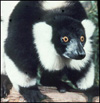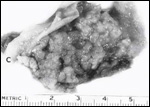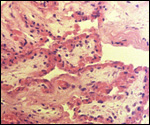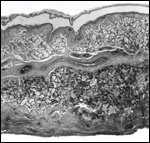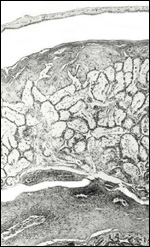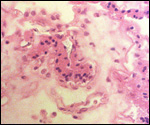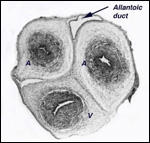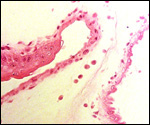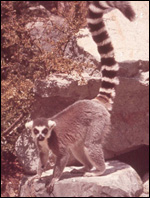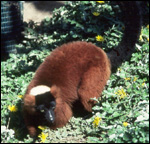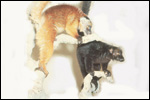| |
9) Trophoblast external to barrier
There is no extravillous trophoblast, and giant cells are not present. There
is also no maternal vascular trophoblastic infiltration or invasion.
10) Endometrium
There is no decidualization of the endometrium. In postpartum uteri, hemosiderin
granules are found in the endometrium.
11)
Various features
There is neither subplacenta nor evidence of metrial glands.
12) Endocrinology
No gonadotropins have been identified in lemurs.
Urinary estrogens were monitored during pregnancy by Shideler et al. (1983).
Total urinary estrogen excretion rose significantly during gestation until
they reached values 1,000 times of those at estrus. Estrone was the major
secretory product.
13)
Genetics
The chromosome number of lemurs is variable; some are here listed: Lemur
catta 2n=56; Lemur coronatus 2n=46; Lemur fulvus albifrons
2n=60; Lemur f. fulvus 2n=48; Lemur macaco 2n=44; Varecia
variegata 2n=46; Hapalemur g. griseus 2n=54; Hapalemur griseus
olivaceus 2n=58; Cheirogaleus major 2n=66; Cheirogaleus
medius 2n=66 (Hsu & Benirschke, 1975).
Hybrids of many lemur species have been recorded by Gray (1972). The two
ruffed lemur species (red and the black & white ruffed lemurs) hybridize
fertilely in captivity. Among the other lemuridae, the hybrids have not
been recorded as being fertile.
A variety of genetic diseases have been described in ruffed lemurs. Naked
lemurs (hairless) have occurred in a London colony. We have described
"sunken chest" (Pectus excavatum) as an inherited deformity
with little illness. Massive skeletal abnormalities may also be inherited.
14) Immunology
I know of no studies that relate to immunological investigations.
15) Pathological features
In captivity, lemurs often develop generalized hemosiderosis and, consequent
to hepatic fibrosis, they may suffer from neoplasms of the liver and bile
ducts. These afflictions have been attributed to a greater avidity for
iron absorption, as apparently they are unknown in freshly captured animals
(Gonzales et al., 1984).
Pectus excavatum is inherited in ruffed lemurs, and so may be their multiple
skeletal anomalies that have been observed in our colony. We have also
seen an acute bacterial infection of the pregnant uterus with acute villitis
and death of the superficial endometrium (Benirschke et al., 1985). Worley
& Stalis (2002) identified a hepadnavirus in the livers of two black
and white ruffed lemurs that died with acute hepatitus.
Although we have often looked for parasites, we have not detected any
in the three species studied.
16)
Physiological data
I know of no blood flow studies before and during pregnancy. We have studied
the absorption of iron in ruffed lemurs and found the ruffed lemur to
have a great avidity for dietary iron. This, we interpreted to be the
result of their dependence in nature on tannic acid-containing food such
as tamarind fruit (Gonzales et al., 1984). Administration of tea instead
of water has reduced this problem in captivity.
17) Other resources
Cell strains of many species of lemurs and related taxa are available
from CRES at the Zoological Society of San Diego.
18)
Other data to be accumulated
It would be of interest to know whether all lemurs have the same placentation
with allantoic sacs. There is need for a better understanding of the genetics
of the congenital anomalies we observed including their possible relationship
to inbreeding.
References
CRES at: http://www.sandiegozoo.org/conservation/cres_home.html.
Please direct your inquiries to Dr. Oliver Ryder (oryder@ucsd.edu).
Benirschke,
K.: Pectus excavatum in ruffed lemurs (Lemur [Varecia] variegatus).
XXII Internatl. Symp. über die Erkrankungen der Zootiere. Arnhem,
Holland, May. Akademie-Verlag, Berlin, pp. 169-172, 1980.
Benirschke, K., Kumamoto, A.T. and Bogart, M.H.: Congenital anomalies
in Lemur variegatus. J. Med. Primatol. 10:38-45, 1981.
Benirschke,
K. and Miller, C.J.: Weights and neonatal growth of ring-tailed lemurs
(Lemur catta) and ruffed lemurs (Lemur variegatus). J. Zoo Anim.
Med. 12:107-111, 1981.
Benirschke, K., Miller, C., Ippen, R. and Heldstab, A.: The pathology
of prosimians, especially lemurs. In: Advances in Veterinary Sciences
and Comparative Medicine. Vol. 30. Academic Press, Inc. pp. 167-208, 1985.
Bogart,
M.H., Cooper, R.W. and Benirschke, K.: Reproductive studies of Lemur m.
macaco, Lemur variegatus subcinctus and Lemur v. ruber.
Internat. Zoo Yrbk. 17:177-182, 1977.
Gonzales, J., Benirschke, K., Saltman, P., Roberts, J. and Robinson, P.T.:
Hemosiderosis in lemurs. Zoo Biol. 3:255-265, 1984.
Gray,
A.P.: Mammalian Hybrids. Second edition. A Check-List with Bibliography.
Commonwealth Agricultural Bureaux, Farnham Royal, Slough, UK, 1972.
Hsu,
T.C. and Benirschke, K.: An Atlas of Mammalian Chromosomes. Springer-Verlag,
New York, 1975.
Mossman,
H.W.: Vertebrate Fetal Membranes. MacMillan, Hound mills, UK, 1987.
Nowak,
R.M. and Paradiso, J.L.: Walker's Mammals of the World, Vol. II. 4th edition.
The Johns Hopkins University Press, 1983.
Puschmann,
W.: Zootierhaltung. Vol. 2 Säugetiere. VEB Deutscher Landwirtschaftsverlag,
Berlin, 1989.
Shideler,
S.E., Czekala, N.M., Benirschke, K. and Lasley, B.L.: Urinary estrogens
during pregnancy of the ruffed lemur (Lemur variegatus). Biol.
Reprod. 28:963-969, 1983.
Worley, M.B. and Stalis, I.H.: Detection of virus-like particles in the
liver of black an white ruffed lemurs with hepatitis. J. Wildl. Dis. 38:258-265,
2002.
Ziswiler,
V.: Extinct and Vanishing Animals. Springer-Verlag, New York, 1967.
Other lemur species from the San Diego Zoo
|
